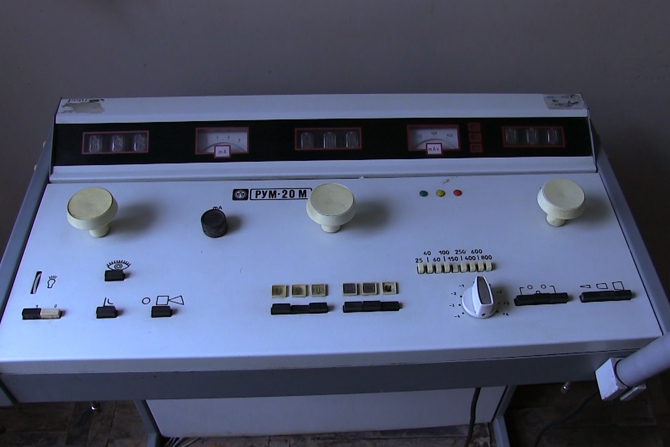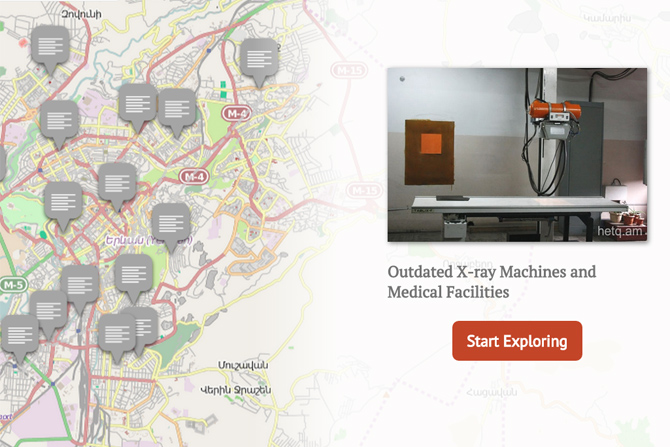
Expired X-ray Machines: Dangers of Radiation a Shut Topic in Armenia
Ani Hovhannisyan, Marine Madatyan
In Yerevan’s polyclinics about 80 percent of the X-ray machines in use are past their expiration date.
The older the radiation machine, the greater the number of risks posed to patients and staff technicians. To define the radiation safety levels the Armenian government passed decision N 1489, which stipulates that if the medical diagnostic cumulative effective dose of radiation for a patient reaches 0.5 Sv, continued exposure is allowed only in cases where it is strongly justifiable.
The Soviet-era X-ray machines used in the capital’s polyclinics were manufactured in the 1970-1980s. They were retired a while ago in the Baltic countries as well as Russia. According to Russian sources, the “Room - 20” and “X-ray 30” machines should be used for 10 years, but they have continued to be in use for 30-40 years in Armenia.
What International Experts Say About Old X-ray Machines
Anders Widmark, senior advisor of the Norwegian Radiation Protection Authority, Department of Radiation Applications, told Hetq about the harmful effects that old X-ray machines can have on people’s health.
“Generally, when the quality of an X-ray image is low, the radiologist is forced to increase the dose of radiation to obtain a clear image,” Widmark said. “In order to imagine how the machine functions you need to understand things. Who will be operating it? Do they have their own dosimeter? Have they received the proper training? Having worked in Nepal for 12 months I can tell you from experience that in developing countries the availability of old machines, and especially operating them, is a problem. Another issue is having to develop the X-ray images using chemicals by hand. In similar countries you also have contradictions between central and rural locations.”
Nepal is not the only country where such things occur. In several of the polyclinics that we visited in Yerevan where old X-ray machines are in use, images were being developed by hand, using chemicals.
The German corporation Siemens is one of the leading companies manufacturing X-ray equipment. Hetq contacted the company to find out what effects old soviet-era machinery has on patients and medical staff. Siemens head of public and media relations Matthias Kraemer explained that doctors operating out-of-date X-ray equipment are obliged to increase the dose of radiation to obtain clear images.
“We can’t comment specifically on soviet-era machines, but for the sake of comparison, the Siemens models manufactured in the 1970-80s were 7-10 generations older than today’s equipment,” Kraemer said.

The effects of ionizing radiation was published in the UNSCEAR 2008 report, which stated that in health care level I countries, the effective dose of diagnostic radiology X-ray examinations, thanks to devices manufactured between 1997-2007, decreased three times compared with the 1970s.
According to data from the World Health Organization, Armenia placed 104 out of 191 in the ranking of world health system efficacy.
Radiation Safety Inspections a Medical Secret?
The Armenian Nuclear Regulatory Authority (ANRA), affiliated with the Armenian government, is responsible for oversight of nuclear and radiation safety in the nuclear power industry. The committee also controls the diagnostic radiation safety levels of X-ray devices in medical institutions. Per the committee’s order, The Nuclear and Radiation Safety Center performs annual inspections in medical institutions, checking the radiation levels of X-ray machines for patients and staff.
Hetq asked ANRA to provide information on the results of radiation and radioactive inspections of medical equipment in Armenia’s polyclinics.

ANRA replied that: “We cannot provide you with that information since the committee does not control it. In accordance with the Republic of Armenia ‘Law on Freedom of Information,’ Point 4 in Part 1 of article 8, the provision of information has been refused since it reveals professional data (medical, notary, legal secrets) requiring restricted access.”
ANRA is the only governmental agency that monitors radiation safety levels and it has refused to provide us with its findings.
The ANRA 2013 annual report provides the only information about performed inspections of medical institutions. In the report the committee came to the following conclusion: “The inspections and licensing procedures reveal that there are still radiation generating sources that are being used longer than their guaranteed. Thus, the possibility of radiation incidents occurring when used is high. We should also note that the use of such machines results in large radiation doses to patients.”

Not all medical centers are equipped with personal protective equipment for staff and patients, and protective measures are not necessarily in place to protect individuals from expired machinery.The level of protection against harmful radioactive levels in medical institutions is not high enough.
The Scientific and Technical Center for Nuclear and Radiation Safety reviewed 13 medical institutions for personal safety measures against radiation and found that the doses were between 0.1mSv-5.0mSv. The center finds the higher dose in the spectrum acceptable since it falls below the annual dose limit of 20 mSv.

How much do ANRA’s guidelines correspond with the norm? Why should patients and staff working with old machines trust ANRA’s figures, especially when no concrete information is made available?
In its 2013 report, the Scientific and Technical Center for Nuclear and Radiation Safety noted that inspections in 19 healthcare facilities revealed that in 20-25 percent of them deviations from the normal parameters of operation were recorded, where diagnostic reference levels in patients detected high doses. In Yerevan only 22 of the state-run polyclinics have X-ray machines, but the Center does not perform reviews in all medical centers. The reasons for that are kept secret by the Center.
Aida Avetisyan, chief radiation specialist at the Scientific and Technical Center for Nuclear and Radiation Safety, told Hetq that agency warned the government about the dangers post by the outdate equipment and suggested they be replaced with new ones.
“We thank the Ministry of Health for doing everything possible to recently upgrade the equipment,” Avetisyan said. “At the same time we’ve made suggestions that outdated machines be replaced in hospitals where there are health risks. We’ve recorded that 70 percent of medical institutions have already upgraded their equipment.”
We pointed out that the Yerevan Municipality’s list of machines in polyclinics revealed that the opposite was true. “There are polyclinics that have new machines and others that don’t,” she said. “But, you know, let’s say we’re responsible for safety risks. I already said that a machine could be old but the parameters might be acceptable to us. In other words that kind of machinefor us does not pose a radiation safety risk for an institution. We tell them that they have to change the machines when they start posing safety risks.”
Meditech LLC is one of the largest importers of X-ray equipment into Armenia. The company’s founder and assistant director Samvel Khachatryan told Hetq that new X-ray machines cost between 150,000 and 200,000 euros, which is a hefty sum for state medical institutions.
“You know what the state’s situation is like—funds are limited for medical centers to receive new equipment,” Khachatryan said. “But last year the City Municipality obtained some equipmentand gave it to polyclinics, and other companies supply them. We haven’t yet supplied polyclinics with equipment, only to private hospitals.”
Khachatryan, who used to work at the Ministry of Health, believes that the directors of medical institutions are responsible for replacing outdated or broken machines.
“I told them repeatedly that for each image taken per day 10 percent of the funds they receive from the government must be allocated towards upgrading the machinery,” he said. “Apathy here and there is astumbling block. But we can’t always say that the outdated machine is the problem. The situation lies in the government being able to upgrade the equipment in all polyclinics, but that costs too much and the funds aren’t there.”
Below are the prices set by the government for the taking of one X-ray as stipulated by the Ministry of Health in 2015.
The government pays polyclinics between 1950 and 2500 AMD for the public to have free X-rays taken with outdated equipment. Those who don’t want to take the risk have to turn to private hospitals and pay out of pocket.
Essentially Armenia’s guaranteed free healthcare system is unsafe and poses health risks.
 Videos
Videos Photos
Photos

Comments (1)
Write a comment